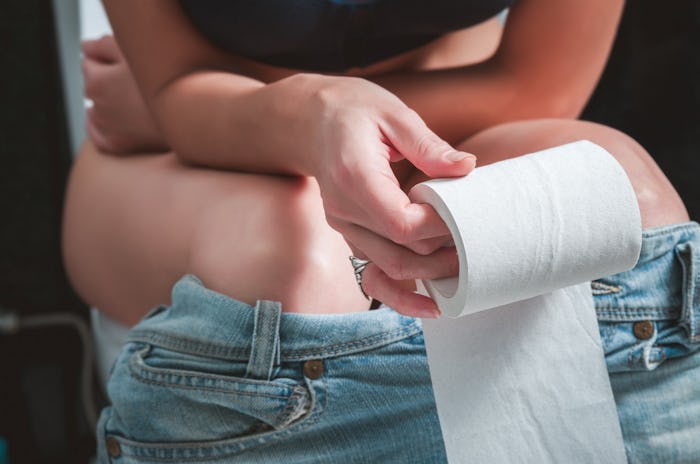Life
If You're Not Pooping In This Position, You're Doing It Wrong
When you're in the bathroom and trying to do what comes naturally, you're not thinking too much about the way in which you're doing it. You've got a toddler standing there and scrutinizing you, or a sibling fight going on in the next room. So your mission is to get off the toilet as quickly as possible so you can get about the business of momming. And it turns out that the best position to poop in isn't the one you might expect; there are better ways to get the job done.
Since the day our parents presented us with our first potty seat and gave us the overly enthusiastic Yay-You're-a-Big-Kid-Now speech, we've been accustomed to going #2 in the #1 position: sitting down, feet on the floor, maybe leaning over a bit for an especially difficult BM. Although we've been conditioned to think of this as a natural position, gastroenterologists explain that it actually makes pooping more difficult, not less.
Kyle Staller, M.D., a gastroenterologist affiliated with Harvard Medical School and Massachusetts General Hospital, tells Romper that sitting down to poop helps relax the puborectalis muscle enough to allow pooping, but that it still takes some effort on your part to push the waste through because the position of the rectum (known as the anorectal angle) is still kinked up. He describes it this way: "When the stool gets to the rectum, think of it as someone at the door you don't want. Are you pushing against a closed door? Then you have to push hard, and you have to open the door."
It seems that our ancestors had the right idea all along: Squatting to poop is both easier and more efficient.
To get an idea of what goes on when you go, think of your colon as a long, twisting tube with a final upside-down kinked curve between the end of the tube (the rectum) and the anus (as shown in this WebMD diagram of the colon). A muscle around the rectum called the puborectalis muscle acts as a barrier to keep poop from coming out when you're standing up. Sitting down helps relax the muscle enough to allow pooping, but it still takes some effort on your part to push the feces through because the position of the rectum (the anorectal angle) is still kinked up.
Dr. Staller adds that using the squat position — knees up above the hips, leaning forward slightly, as if you were squatting over a hole — relaxes the puborectalis muscle completely and straightens out the, um, poop chute, allowing waste to empty out quickly and thoroughly. "Straightening the rectum is very helpful," he explains.
Assuming an optimal position can help prevent or relieve constipation, a painful condition which affects 10 percent of the population, Staller adds. "Constipation may never kill you, but it may make you want to die sometimes," he says. Proper pooping can save you money as well; a report published by the National Institutes of Health stated that Americans spend more than $800 million on laxatives every year.
Although clinical research on the subject has been rather limited so far, the findings are still promising. One small Israeli study asked male volunteers to time how long it took them to eliminate under three conditions: sitting on a standard toilet seat, sitting on a toilet lower to the ground, and squatting. The men recorded much faster times when squatting as compared to both seated positions. What's more, they didn't need to strain as much, and they felt more thoroughly emptied out.
Achieving optimal poop position can be as simple as resting your feet on a low stand and leaning forward slightly to keep your knees above your hips. The famous Squatty Potty is specially designed to put your body in the proper spot, and similar stools are also available. Staller tells Romper that any device that helps elevate your knees should help. "It's not that I recommend that everyone do it, but if you're having trouble, changing position can help," he explains. "There's nothing from a gastrointestinal perspective not to use it."
The squatting movement (ahem) does have its detractors. Northwestern University gastroenterologist Darren Brenner, M.D., told a reporter at Men's Health that while changing poop position is a "harmless, potentially healthy" technique to try, there just isn't enough evidence to conclude that it's medically necessary for everyone.
In short, becoming a toilet squatter may not be a life-changer for you, but it might just make things more comfortable and save you some time. Then you can use the time you save for important business, such as reminding your kids for the hundredth time to flush.
Studies Referenced:
Sikirov, D. (2003). Comparison of straining during defecation in three positions: results and implications for human health. Digestive Diseases and Sciences, https://pubmed.ncbi.nlm.nih.gov/12870773/
Experts:
Kyle Staller, M.D., gastroenterologist affiliated with Harvard Medical School and Massachusetts General Hospital
This post was originally published on 7/17/2019. It was updated on 8/30/2019.
This article was originally published on
